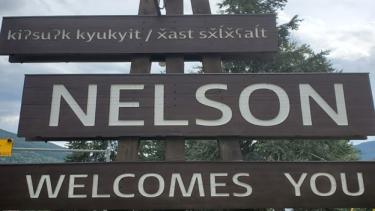Check Out the Awesome: LVR

The semester is wrapping up here at the LV Rogers and with it comes the final exams and assessments. One of the assessments that the English First Peoples 12 class participated in was an oral language assessment for their Indigenous language component of the course.
All semester long, students were involved in weekly language lessons in n̓səl̓xčin̓, one of the local Indigenous languages of the Nelson area. Students learned basic greetings like Good morning and Good afternoon, as well as the basics for a conversation. Students then formed groups to present their language skills to the class in a fun and interesting way. It was so impressive! Students were able to converse in a meaningful way. They talked about how they were feeling, their age, the colours they like, their physical descriptions and what they were like (hard working, lazy, talkative, mean etc). These students should be celebrated for their learning.
So why are we learning Indigenous languages in school? This is a question that I get often at the beginning of the course, “This is an English class, why am I learning this language?” and the answer is respect. We live and go to school here on unceded territory and it is a minimum of respect to learn the language of the land. The language that has been spoken here for thousands of years. They say that when the language of the land is spoken, the ancestors rise up.
As people who live in a time after the Truth and Reconciliation Commission report, we, as Canadians, have a responsibility to work on reconciliation, which is a long road. Learning Indigenous languages is one of the calls to action that schools can easily take action on. Learning the local language also helps reinforce the reciprocal relationship between Indigenous and Non-Indigenous peoples and offers a sign of respect. When our students go to an event with Sinixt or Sylix people who introduce themselves in their language, they now know what is being said and students have told us that makes them feel like they are part of a change and a new relationship of respect can begin.
Students can also then read the sign coming in and out of the city of Nelson. As someone who commutes in from Harrop every day, I pass that sign and am thankful for the positive message in the three languages that sign represents. Ki’suk kyukyit, the Ktunaxa word for Greetings, and which means Good Day in n̓səl̓xčin̓.
As a Métis person, who hails from Treaty 6, in Amiskwaciwâskahikan / ᐊᒥᐢᑲᐧᒋᐋᐧᐢᑲᐦᐃᑲᐣ (Edmonton) which translate to Beaver Hills House, I have learned that as a guest on this land, learning the language is the least I can do to live here with an attitude toward reconciliation. And the language of the land speaks to the importance of local Indigenous knowledge, which I am keen to learn and to pass the teachings on the students at LV Rogers.

